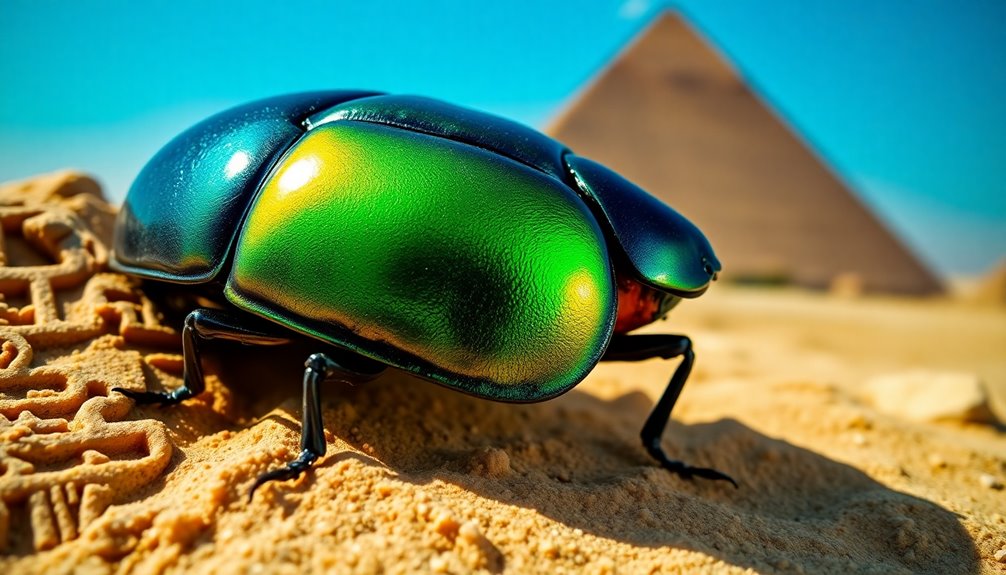In the ultimate showdown between the Eye of Horus and the Eye of Ra, you see two powerful forces vying for dominance in ancient Egyptian mythology. The Eye of Horus embodies protection, healing, and wisdom, symbolizing Horus's triumph over evil. In contrast, the Eye of Ra represents fierce authority and punishment, reflecting the relentless power of the sun god. While the Eye of Horus offers nurturing and safety, the Eye of Ra instills fear and respect. Together, they illustrate a profound duality in divine energy. Want to explore the deeper implications of this epic clash? There's much more to uncover!
Key Takeaways
- The Eye of Horus symbolizes protection and healing, while the Eye of Ra represents fierce authority and punishment, showcasing their contrasting powers.
- Horus's lost eye signifies regeneration after conflict, whereas Ra's eye emphasizes control and the consequences of disobedience.
- Artistic depictions differ: Horus's eye features a calming blue iris, while Ra's eye has a fierce red iris, reflecting their unique attributes.
- Both eyes served as protective amulets in ancient Egypt, guiding health and safety through their respective spiritual meanings.
- The clash between Horus and Ra illustrates the duality of divine power, merging restoration and aggression within ancient Egyptian mythology.
Symbolism and Meaning
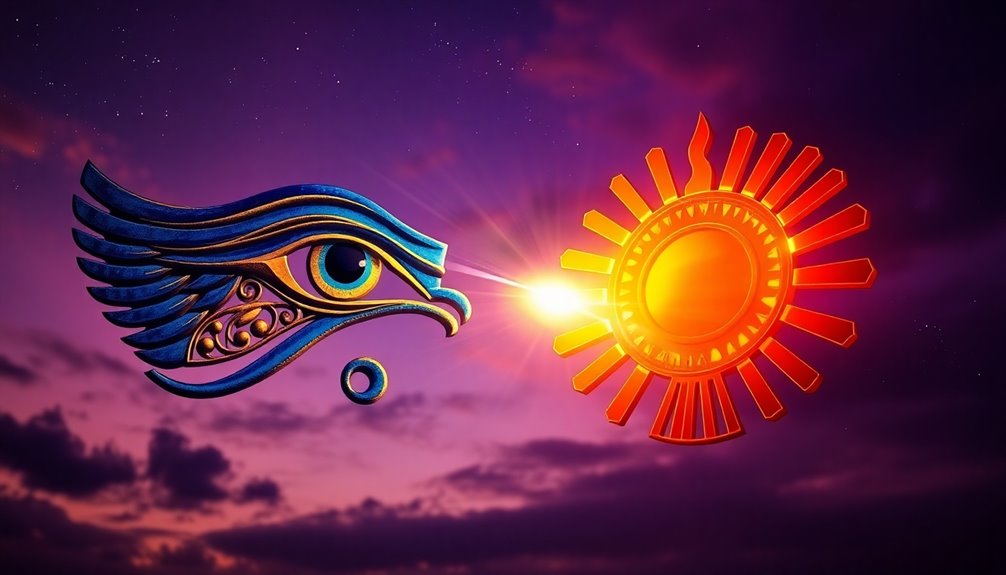
The Eye of Horus and the Eye of Ra each carry profound symbolism and meaning that reflect their unique attributes in ancient Egyptian mythology.
The Eye of Horus represents protection, acting as a shield against misfortune and negative energies. It's associated with healing, rejuvenation, and the restoration of health, serving as a symbol of wisdom and divine connection. This eye embodies the triumph of good over evil, highlighting the victory of virtue and light. Additionally, it acts as a talisman for positive energy, enhancing personal space and attracting good fortune.
In contrast, the Eye of Ra symbolizes the immense power of the sun god Ra. It embodies his ability to protect and punish, showcasing a fiercer aspect of divine power. Linked to fury and violence, this symbol reflects the punishment that Ra's daughter metes out to disrespectful followers.
While the Eye of Horus focuses on healing and compassion, the Eye of Ra emphasizes control and authority.
Both symbols are crucial in ancient Egyptian culture, serving as protective amulets and talismans. Their meanings extend beyond mythology into everyday life, offering guidance for health, prosperity, and protection, making them timeless symbols of strength and safety.
Mythological Origins

In exploring the mythological origins of the Eye of Horus and the Eye of Ra, you uncover rich narratives that highlight the themes of protection, revenge, and divine authority.
The Eye of Horus stems from the tragic tale of Osiris, who was murdered by his brother Set. Born to avenge his father's death, Horus lost his eye in battle with Set. Thoth, the moon god, gathered the eye's scattered pieces and restored it, symbolizing healing and regeneration. This act made the Eye of Horus a powerful emblem of protection and royal power, as it was believed to guide spirits in the afterlife.
On the other hand, the Eye of Ra represents a more aggressive force. Ra, angered by his followers, sent his daughter in lion form to punish them. Her violent actions illustrated Ra's power and authority, contrasting sharply with Horus' protective nature.
The Eye of Ra embodies Ra's capacity for both punishment and protection, emphasizing fear and respect. Together, these mythological origins depict the duality of divine power, with Horus symbolizing healing and revenge, while Ra signifies fury and authority, setting the stage for their ultimate showdown.
Depiction and Appearance

When examining the depiction and appearance of the Eye of Ra and the Eye of Horus, you'll notice striking contrasts that reflect their distinct mythological roles. The Eye of Ra, depicted as the right eye, is associated with the sun's fierce energy. It often features a red iris, symbolizing the sun's heat, and can be represented as a cobra encircling a sun disk. This imagery signifies Ra's protective power and aggressive force, frequently accompanied by symbols like a teardrop or flames.
In contrast, the Eye of Horus is shown as the left eye and symbolizes the calming, restorative powers of the moon. With a blue iris, it represents healing, often incorporating markings resembling a falcon. This imagery conveys Horus's protective gaze, rooted in regeneration. The Eye of Horus is widely recognized for its association with healing and restoration, further emphasizing its significance in ancient Egyptian mythology.
The color differences are significant; Ra's red symbolizes power and fury, while Horus's blue signifies calmness and healing.
Artistic representations of both eyes appear in various media, from jewelry to temple walls, reinforcing their roles as powerful symbols in ancient Egyptian mythology. Each eye not only serves a protective function but also embodies different aspects of life and divinity.
Cultural Usage in Ancient Egypt
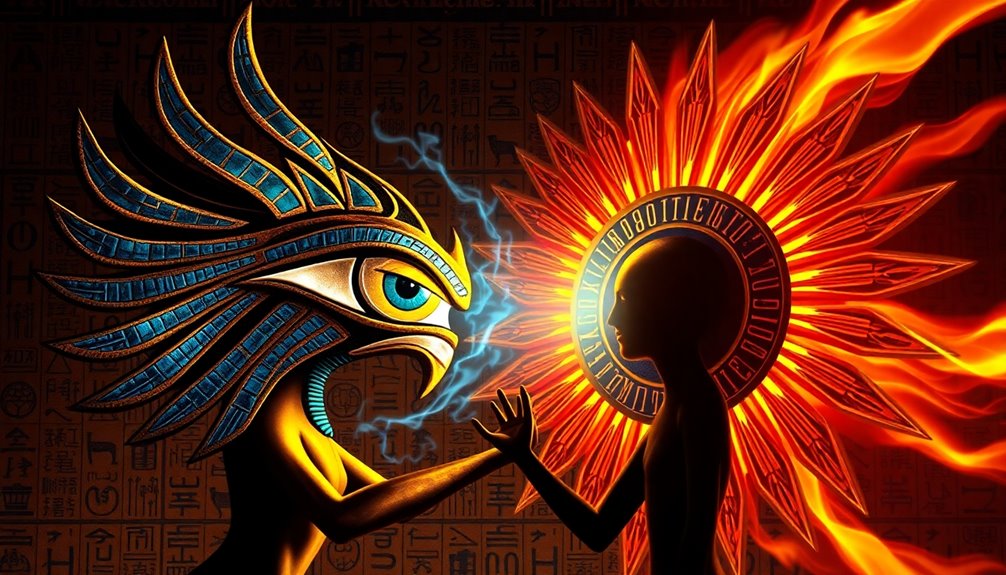
Throughout ancient Egypt, the Eye of Horus and the Eye of Ra held profound cultural significance, influencing various aspects of daily life and religious practices.
The Eye of Horus, or Wedjat eye, symbolized healing, protection, and wisdom. People wore amulets featuring this eye to invoke divine powers and safeguard against ailments, embodying the cosmic order of Ma'at. It was common to see the Eye of Horus in jewelry and art, offering spiritual and regenerative protection. The Eye of Horus is also often associated with healing processes linked to the phases of the moon.
In contrast, the Eye of Ra represented the sun god's destructive power. It was linked to his daughter, who punished humanity, embodying the sun's fury. This fierce aspect found its way into daily life through rituals and offerings.
Both eyes appeared in medical practices, with Horus's eye equated with healing efforts and protection against eye diseases.
Artistic expressions showcased these symbols extensively, from coffins to stelae, reinforcing their significance in funerary contexts.
The Eyes weren't just symbols; they were integral to maintaining harmony and balance, reflecting the ancient Egyptians' deep spiritual beliefs and their understanding of life and death.
Key Gods and Goddesses
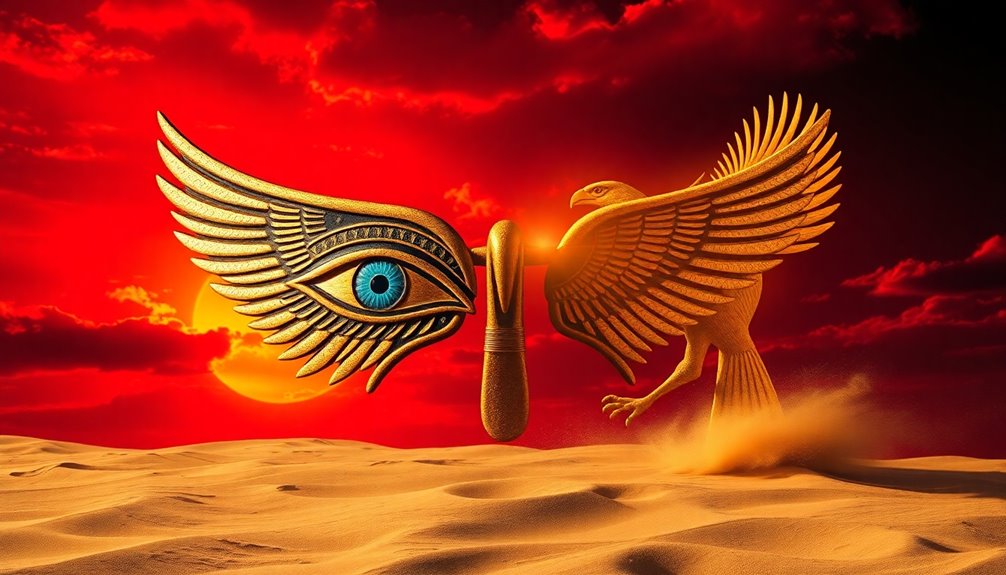
The Eye of Horus and the Eye of Ra are deeply intertwined with the key gods and goddesses of ancient Egyptian mythology, each representing unique aspects of life and the cosmos. Horus, the sky god, avenged his father Osiris's death by defeating Seth, becoming the rightful king of Egypt. His eye symbolizes protection and restoration, thanks to Thoth, the lunar god associated with wisdom and magic. The Eye of Horus is also believed to possess healing and protective powers, making it a significant symbol in ancient and modern contexts.
Osiris, the god of the afterlife, represents the cycle of death and rebirth, while his wife Isis embodies motherhood and magic, playing a vital role in Horus's upbringing. On the other hand, Ra, the sun god, reigns as the king of the deities, representing creation and authority. His daughter, the Eye of Ra, personifies his fierce nature, punishing disobedience. Seth, the antagonist, symbolizes chaos and disorder, often clashing with Horus. Meanwhile, Wadjet, associated with the Eye of Horus, embodies protection and justice.
Together, these figures weave a complex narrative of power, conflict, and divine order in ancient Egyptian mythology, highlighting the intricate relationships among them.
Cultural Significance

In ancient Egyptian culture, the Eye of Horus and the Eye of Ra held profound significance, influencing daily life and spiritual practices.
The Eye of Horus symbolized protection and healing. People believed it could ward off evil, making it a popular talisman for both the living and the deceased. You'd often find it inscribed on amulets and jewelry, ensuring safety for individuals and communities. Its connection to healing came from the myth of Horus' eye being restored by Thoth, representing rejuvenation and divine intervention. This symbol of protection was not only prevalent in personal adornments but also integrated into the architectural designs of sacred spaces.
On the other hand, the Eye of Ra embodied power and authority. It represented the sun god Ra's ability to protect and punish, often depicted as a fierce right eye. Pharaohs used it to maintain control, reinforcing their divine right to rule. The Eye of Ra also reflected a more destructive aspect, connected to the myth of Ra's daughter punishing humanity.
Both symbols transcended time, appearing in various contexts from ancient art to modern culture.
While the Eye of Horus represents protection and healing, the Eye of Ra conveys power and authority, showcasing the complexity of ancient Egyptian spirituality.
The Ultimate Showdown
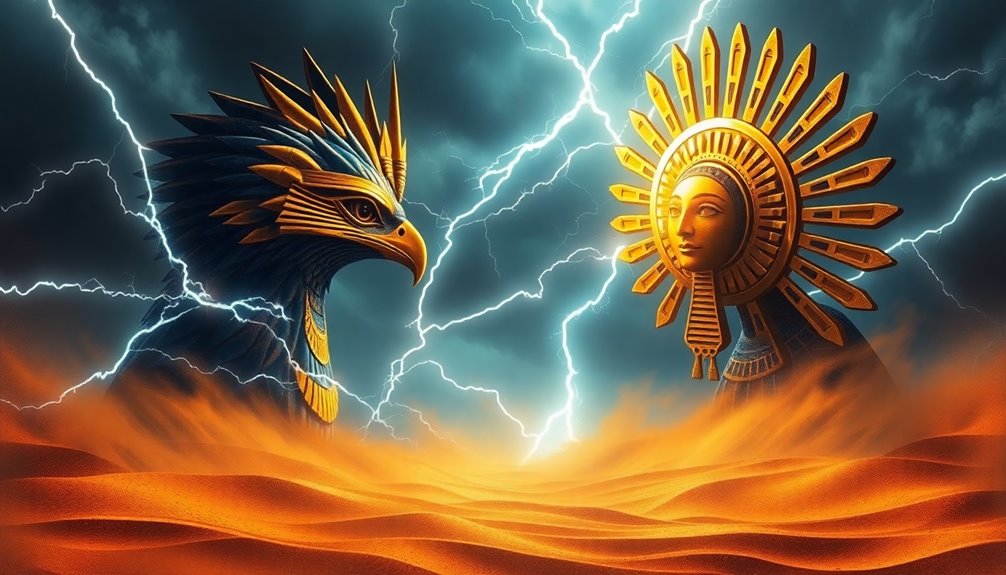
When it comes to the epic clash between the Eye of Horus and the Eye of Ra, both symbols represent powerful forces in ancient Egyptian mythology, each with its unique strengths and attributes.
The Eye of Ra, linked to the sun god Ra, emerges as a fierce protector, unleashing destruction when angered. Created by Hathor, this eye embodies punishment and royal power, capable of seeing all that transpires in the world. Its teardrop and cobra motifs emphasize its ferocity. This eye symbolizes the destructive force of the sun, reflecting the duality of creation and destruction.
In contrast, the Eye of Horus symbolizes healing and protection. It's tied to Horus, the son of Osiris and Isis, and represents his struggle against Set. After losing his eye, Horus received restoration from Thoth, turning the eye into a symbol of divine sight and enlightenment. Often depicted with falcon-like markings, it's an emblem of safety and prosperity, commonly used in amulets.
As these two eyes face off, you see a battle between raw power and protective wisdom. The Eye of Ra's destructive force collides with the Eye of Horus's nurturing essence, making this showdown one of profound significance in the realm of ancient Egyptian myth.
Frequently Asked Questions
How Did the Eye of Horus Influence Modern Symbols?
The Eye of Horus has significantly shaped modern symbols by embodying protection, healing, and spirituality.
You'll find its influence in jewelry, tattoos, and art, where it evokes ancient wisdom and mystique. This symbol resonates with those seeking deeper connections to their heritage.
It's also recognized globally, appearing in various media and design, reinforcing its role as a universal emblem of hope and safety.
Its enduring appeal continues to inspire contemporary culture.
Are There Any Historical Artifacts Featuring Both Eyes?
Yes, there are historical artifacts featuring both the Eye of Horus and the Eye of Ra.
You can find them in various Egyptian jewelry pieces and amulets, symbolizing protection and power.
Often, both eyes appear together in decorative carvings and temple reliefs, representing the balance between healing and strength.
These artifacts serve as reminders of the divine protection and cosmic order that ancient Egyptians valued deeply in their culture and beliefs.
Can the Eyes Be Combined in Symbolic Meaning?
Yes, you can definitely combine the symbolic meanings of the Eye of Horus and the Eye of Ra.
Together, they represent a balance between protection and power, healing and fury. The Eye of Horus brings regeneration and wholeness, while the Eye of Ra embodies strength and authority.
When you merge these symbols, you capture the duality of life, emphasizing that both nurturing and fierce aspects are essential for harmony in the universe.
What Role Do These Symbols Play in Contemporary Spirituality?
In contemporary spirituality, symbols like the Eye of Horus play a significant role by offering protection, healing, and a sense of divine perception.
You might wear it as an amulet to ward off negativity or incorporate it into your art to express resilience.
These symbols connect you to ancient wisdom while reminding you of life's dualities, encouraging balance and harmony in your spiritual journey.
Their timeless appeal resonates deeply with your quest for meaning.
How Have Artists Represented These Eyes Throughout History?
Throughout history, artists have represented the Eye of Horus and the Eye of Ra in various ways.
You'll notice the Eye of Horus often appears in funerary art, symbolizing protection and healing, while the Eye of Ra is depicted with a more fierce expression, representing power.
Both eyes are adorned in jewelry and sculptures, keeping their symbolic meanings alive. Their representations evolve, but their essence of protection and divine insight remains constant.
Conclusion
In the epic clash between the Eye of Horus and Ra, you discover the rich tapestry of ancient Egyptian mythology. Both symbols carry powerful meanings, representing protection, power, and the divine. As you explore their origins and cultural significance, you realize that these iconic figures aren't just relics of the past; they continue to inspire and intrigue. Ultimately, this showdown highlights the enduring legacy of these deities, reminding you of the fascinating stories that shaped civilization.

